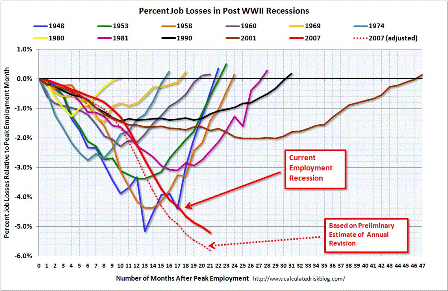Looking for more of the same with the preponderance of ‘top down’ initiatives.
Wall street banks dividing up tens of billions in bonuses, as fees and net interest margins remain wide, helped by income lost by ‘savers’ due to fed rate cuts, while unit labor costs plunge with productivity high and wages stagnating.
Negative headline CPI means no social security increase, unemployment near 10% and jobs still being lost, foreclosures running at record levels, and mortgage delinquencies continuing to climb.
And now with real GDP growing at maybe 3% and lower income groups still going backwards, a larger chunk of the output has to be going to the top.
Wealthy U.S. Shoppers Boost Spending 29%
By Cotten Timberlake
Oct. 16 (Bloomberg) — Spending in the U.S. on luxury goods and services spurted 29 percent in the third quarter from the previous three months, as consumers with the highest incomes unleashed pent-up demand, according to Unity Marketing.
Spending among 1,067 consumers with average annual income of $228,800 rose to $18,826 each in the three months ended in September from $14,554 a quarter earlier, the Stevens, Pennsylvania-based luxury-market research firm said today. Shoppers cut spending by 3.2 percent in the second quarter and spent $13,429 in the third quarter of 2008.
The increase was driven by consumers with the highest income levels, starting at $250,000 a year, said Pam Danziger, Unity’s Marketing’s president. Spending was strongest in the home, travel and dining segments, she said. The wealthy curbed purchasing earlier this year because of Wall Street job cuts, lower home values and volatile financial markets.
“No question that this quarter’s spending increase is good news for luxury marketers,†Danziger said in a telephone interview today. “Many affluent consumers returned after sitting on the sidelines for a year. However, the richest are few in number, 2.5 million households, so competition will be fierce to win their attention.â€
MasterCard Report
U.S. luxury sales rose 3.4 percent to $891 million in September from a year earlier, the first such gain since August 2008, according to figures provided today by credit-card company MasterCard in its SpendingPulse report. Last month, those sales fell 13 percent from the previous year.
The luxury category covers apparel, leather goods and department-store sales at the highest 10 percent of prices. SpendingPulse measures retail sales across all payment forms, including cash and checks.
United Marketing said purchases increased in all but three of the 22 product and service categories it tracks.
The highest-income group spent an average of $43,111 in the latest quarter and the lowest-income group tracked, with earnings of $100,000 to $149,999, spent $10,423. The three categories that didn’t gain were fashion accessories, fashion apparel and art, Danziger said.
Gains in confidence among luxury consumers, meanwhile, slowed, Unity Marketing said.
The researcher’s luxury confidence index rose 1.6 points to 75.9, after jumping 18.6 points to 74.3 in the previous quarter. That index peaked at 113.2 at the end of March 2006. Its low was 40.3 in September 2008. It started at 100 in January 2004.
The findings were based on a survey conducted among adults aged 24 to 70 with income of at least $100,000 from Oct. 2 to Oct. 7. Unity Marketing does not calculate a margin of error. It plans to publish the survey results Oct. 19.
[top]


